
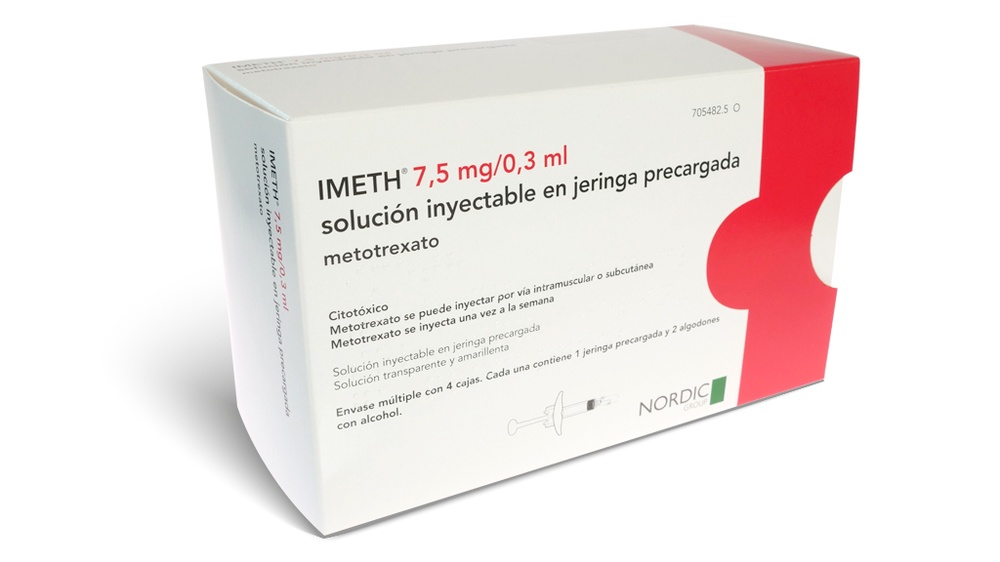
ИМЕТ 7,5 мг/0,3 мл раствор для инъекций в предварительно заполненном шприце


Инструкция по применению ИМЕТ 7,5 мг/0,3 мл раствор для инъекций в предварительно заполненном шприце
Введение
Инструкция: информация для пользователя
ИМЕТ7,5мг/0,3 млраствор для инъекций в предварительно заполненном шприце
Метотрексат
Прочитайте внимательно всю инструкцию перед началом использования этого лекарства, поскольку она содержит важную информацию для вас.
- Сохраните эту инструкцию, поскольку вам может потребоваться прочитать ее снова.
- Если у вас есть какие-либо вопросы, проконсультируйтесь с вашим врачом или фармацевтом.
- Это лекарство было назначено только вам, и не передавайте его другим людям, даже если у них такие же симптомы, как у вас, поскольку оно может нанести им вред.
- Если вы испытываете побочные эффекты, проконсультируйтесь с вашим врачом или фармацевтом, даже если это побочные эффекты, которые не указаны в этой инструкции. См. раздел 4.
Содержание инструкции
- Что такое ИМЕТ и для чего он используется
- Что вам нужно знать перед началом использования ИМЕТ
- Как использовать ИМЕТ
- Возможные побочные эффекты
- Хранение ИМЕТ
- Содержание упаковки и дополнительная информация
1. Что такое ИМЕТ и для чего он используется
Имет - это лекарство, которое имеет следующие свойства:
- Вмешивается в рост определенных клеток организма, которые быстро размножаются (антитуморное средство).
- Снижает нежелательные реакции собственной иммунной системы организма (иммунодепрессивное средство).
- Имеет противовоспалительные эффекты.
Имет показан для лечения:
- Активной ревматоидной артриты у взрослых пациентов.
- Полиартикулярных форм ювенильного идиопатического артрита у детей и подростков, когда ответ на нестероидные противовоспалительные препараты (НПВП) был недостаточным.
- Тяжелой псориаза, не поддающейся лечению другими методами, такими как фототерапия, ПУВА и ретиноиды, и псориатического артрита у взрослых пациентов.
- Легкой и умеренной степени активности болезни Крона у взрослых пациентов, которые не переносят или не реагируют на тиопуриновые препараты.
2. Что вам нужно знать перед началом использования ИМЕТ
Важное предупреждение, связанное с применением метотрексата:
Метотрексат должен использоваться только один раз в неделю для лечения ревматических или кожных заболеваний. Неправильное применение метотрексата может вызвать серьезные побочные эффекты, включая смертельные исходы. Прочитайте внимательно раздел 3 этой инструкции.
Спросите вашего врача или фармацевта, если у вас есть какие-либо вопросы перед использованием Имет.
Не используйтеИМЕТ:
- Если вы аллергичны (гиперчувствительны) к метотрексату или любому другому компоненту этого лекарства (см. раздел 6).
- Если у вас есть серьезные проблемы с почками (ваш врач определяет степень тяжести заболевания).
- Если у вас есть серьезные проблемы с печенью (ваш врач определяет степень тяжести заболевания).
- Если у вас есть нарушения системы кроветворения.
- Если ваш потребление алкоголя высоко.
- Если у вас есть нарушения иммунной системы.
- Если у вас есть серьезные инфекции или они существуют; например, туберкулез и ВИЧ.
- Если у вас есть язвы желудочно-кишечного тракта.
- Если вы беременны или кормите грудью (см. раздел "Беременность, лактация и фертильность").
- Если вы одновременно получаете вакцины с живыми микроорганизмами.
Предупреждения и меры предосторожности
С метотрексатом было зарегистрировано острое легочное кровотечение у пациентов с основным ревматологическим заболеванием. Если вы замечаете кровь при кашле или откашливании, немедленно свяжитесь с вашим врачом.
Если вы, ваш партнер или ваш опекун заметили появление или ухудшение неврологических симптомов, таких как общая мышечная слабость, нарушение зрения, изменения в мышлении, памяти и ориентации, вызывающие путаницу и изменения личности, свяжитесь с вашим врачом немедленно, поскольку это может быть симптомами редкого тяжелого церебрального заболевания, называемого прогрессивной мультифокальной лейкоэнцефалопатией (ПМЛ).
Метотрексат может сделать кожу более чувствительной к солнечному свету. Избегайте интенсивного солнечного света и не используйте солнечные лампы или ультрафиолетовые лампы без консультации с врачом. Чтобы защитить кожу от интенсивного солнечного света, носите подходящую одежду или используйте солнцезащитный крем с высоким фактором защиты.
Проконсультируйтесь с вашим врачом перед началом использования Имет
- Если у вас есть сахарный диабет, леченный инсулином.
- Если у вас есть хронические неактивные инфекции (например, туберкулез, гепатит Б или С, герпес [герпес зостер]).
- Если у вас есть или были какие-либо заболевания печени или почек.
- Если у вас есть проблемы с функцией легких.
- Если у вас есть сильное ожирение.
- Если у вас есть аномальное накопление жидкости в брюшной полости или в полости, расположенной между легкими и грудной стенкой (асцит, плевральный выпот).
- Если вы обезвожены или страдаете от какого-либо расстройства, которое может вызвать обезвоживание (рвота, диарея, стоматит).
Лечение должно назначаться один раз в неделю.
Неправильное применение метотрексата может вызвать серьезные побочные эффекты, включая потенциально смертельные. Прочитайте внимательно раздел 3 этой инструкции.
Если у вас были кожные проблемы после радиотерапии (радиационный дерматит) и солнечные ожоги, эти состояния могут повториться во время лечения метотрексатом (реакция памяти).
Использование у детей, подростков и пожилых пациентов
Инструкции по применению зависят от веса пациента. Не рекомендуется использовать у детей младше 3 лет, поскольку опыт использования этого препарата в этой возрастной группе недостаточен.
Дети и пожилые пациенты, получающие лечение Имет, должны находиться под частым медицинским наблюдением для выявления возможных побочных эффектов.
Врач должен внимательно наблюдать за пожилыми пациентами, получающими лечение метотрексатом, для выявления возможных побочных эффектов.
У пожилых пациентов, в случае возрастной почечной и печеночной недостаточности и низких запасов фолиевой кислоты в организме, требуется относительно низкая доза метотрексата.
Особые меры предосторожности во время лечения Имет
Имет должны назначать только врачи с достаточным опытом лечения метотрексатом заболевания, которое у вас есть.
Метотрексат временно влияет на производство сперматозоидов и яиц. Метотрексат может вызвать выкидыши и тяжелые врожденные дефекты. Если вы женщина, вы должны избегать беременности во время приема метотрексата и в течение как минимум 6 месяцев после окончания лечения метотрексатом. Если вы мужчина, вы должны избегать зачатия ребенка во время приема метотрексата и в течение как минимум 3 месяцев после окончания лечения.
См. также раздел «Беременность, лактация и фертильность».
Кожные поражения, вызванные псориазом, могут ухудшиться во время лечения Имет, если одновременно происходит воздействие ультрафиолетового излучения.
Рекомендуемые исследования и меры предосторожности:
Даже при использовании метотрексата в низких дозах могут возникать серьезные побочные эффекты. Чтобы их выявить, ваш врач будет проводить исследования и лабораторные тесты.
До начала лечения:
До начала лечения у вас будет сделан анализ крови, чтобы определить, достаточно ли у вас кровяных клеток. Также будет сделан анализ крови, чтобы проверить функцию печени и выявить гепатит. Кроме того, будут проверены уровни сывороточного альбумина (белка крови), состояние гепатита (инфекции печени) и функция почек. Врач также может решить провести другие исследования печени, которые могут включать получение изображений печени или взятие небольшой пробы ткани печени для более тщательного исследования. Также возможно, что врач проверит, есть ли у вас туберкулез, и сделает рентгенографию грудной клетки или тест функции легких.
Во время лечения:
Врач может провести следующие исследования:
- Обследование полости рта и горла для выявления изменений в слизистой оболочке, таких как воспаление или язвы.
- Анализ крови/гемограмма с подсчетом кровяных клеток и измерением уровня метотрексата в сыворотке.
- Анализ крови для контроля функции печени.
- Исследования с помощью изображений для контроля состояния печени.
- Получение небольшой пробы ткани печени для более тщательного исследования.
- Анализ крови для контроля функции почек.
- Контроль дыхательных путей и, если необходимо, тест функции легких.
Очень важно, чтобы вы прошли эти запланированные исследования.
Если результаты некоторых из этих тестов будут аномальными, ваш врач отрегулирует лечение соответственно.
Другие лекарства и ИМЕТ
Сообщите вашему врачу или фармацевту, если вы используете, недавно использовали или можете использовать любое другое лекарство, включая лекарства, приобретенные без рецепта, и травяные или натуральные продукты.
Особенно важно, чтобы вы сообщили вашему врачу, если вы используете:
- Другие методы лечения ревматоидного артрита или псориаза, такие как лефлуномид, сульфасалазин (также используемый для лечения язвенного колита), аспирин, фенилбутазон или амидопирин.
- Алкоголь (должен быть избегаем).
- Вакцины с живыми микроорганизмами.
- Азатиоприн (используется для предотвращения отторжения после трансплантации органа).
- Ретиноиды (используются для лечения псориаза и других кожных заболеваний).
- Противоэпилептические препараты (для предотвращения судорог).
- Лекарства против рака.
- Барбитураты (инъекции для сна).
- Транквилизаторы.
- Оральные контрацептивы.
- Пробенецид (против подагры).
- Антибиотики.
- Пириметамин (используется для предотвращения и лечения малярии).
- Витаминные препараты, содержащие фолиевую кислоту.
- Ингибиторы протонной помпы (используются для лечения сильной кислотности желудка или язвы).
- Теофиллин (используется для лечения астмы).
- Метамизол (синонимы: новаминсульфон и дипирон) (лекарство для сильной боли и/или лихорадки).
Использование ИМЕТ с продуктами питания, напитками и алкоголем
Во время лечения Имет следует избегать потребления алкоголя и чрезмерного потребления кофе, газированных напитков с кофеином и черного чая.
Также убедитесь, что вы потребляете большое количество жидкости во время лечения Имет, поскольку обезвоживание (снижение количества воды в организме) может увеличить токсичность Имет.
Беременность, лактация и фертильностьЕсли вы беременны или кормите грудью, считаете, что можете быть беременной или планируете стать беременной, проконсультируйтесь с вашим врачом перед использованием этого лекарства.
Беременность
Не используйте Имет во время беременности или если вы пытаетесь стать беременной. Метотрексат может вызвать врожденные дефекты, повредить плоду или вызвать выкидыши. Он ассоциируется с аномалиями развития черепа, лица, сердца и сосудов, мозга и конечностей. Поэтому очень важно, чтобы метотрексат не назначался беременным женщинам или тем, кто планирует стать беременным. У женщин детородного возраста должна быть исключена любая возможность беременности с помощью соответствующих мер, например, теста на беременность перед началом лечения. Вы должны избегать беременности во время приема метотрексата и в течение как минимум 6 месяцев после окончания лечения, используя для этого надежные методы контрацепции в течение всего этого времени (см. также раздел «Предупреждения и меры предосторожности»).
Если вы становитесь беременной во время лечения или подозреваете, что можете быть беременной, проконсультируйтесь с вашим врачом как можно скорее. Вам будет предоставлена информация о риске вредного воздействия на ребенка во время лечения.
Если вы хотите стать беременной, проконсультируйтесь с вашим врачом, который может направить вас к специалисту для консультации перед планируемым началом лечения.
Лактация
Не кормите грудью во время лечения, поскольку метотрексат проникает в грудное молоко. Если ваш врач считает, что лечение метотрексатом абсолютно необходимо во время лактации, вы должны прекратить грудное вскармливание.
Мужская фертильность
Доступные данные не указывают на повышенный риск дефектов или выкидышей, если отец принимает дозу метотрексата менее 30 мг/неделю. Однако этот риск нельзя полностью исключить. Метотрексат может быть генотоксичным, то есть вызывать генетические мутации. Метотрексат может влиять на производство сперматозоидов и вызывать врожденные дефекты. Поэтому вы должны избегать зачатия ребенка или донорства спермы во время приема метотрексата и в течение как минимум 3 месяцев после окончания лечения.
Вождение и использование машин
Во время лечения Имет могут возникать побочные эффекты, влияющие на центральную нервную систему, такие как усталость и головокружение. Поэтому в некоторых случаях может быть нарушена способность управлять транспортными средствами и/или использовать машины. Если вы чувствуете усталость или головокружение, не должны управлять транспортными средствами или использовать машины.
ИМЕТ содержит натрий
Это лекарство содержит менее 1 ммоль натрия (23 мг) на дозу, то есть практически не содержит натрия.
3. Как использовать ИМЕТ
Важное предупреждение о дозировке Имета (метотрексата):
Используйте Имет только один раз в неделюдля лечения ревматоидного артрита, активной ювенильной идиопатической артрита, псориаза, псориатического артрита и болезни Крона. Чрезмерное использование Имета (метотрексата) может быть смертельным. Прочитайте раздел 3 этого листка внимательно. Если у вас есть какие-либо сомнения, проконсультируйтесь с вашим врачом или фармацевтом перед приемом этого лекарства.
Следуйте точно инструкциям по применению этого лекарства, указанным вашим врачом. В случае сомнений проконсультируйтесь снова с вашим врачом или фармацевтом.
Имет вводится только один раз в неделю. Вы можете решить вместе с вашим врачом, какой день недели будет наиболее подходящим для каждой недели, когда вы будете получать свою инъекцию.
Неправильное введение Имета может вызвать серьезные побочные эффекты, включая потенциально смертельные.
Нормальная доза:
Дозировка у пациентов с ревматоидным артритом
Рекомендуемая начальная доза составляет 7,5 мг метотрексата один раз в неделю. Имет вводится в виде одной инъекции под кожу (см. раздел "Метод и продолжительность введения").
Если это оказывается недостаточным и хорошо переносится, дозы Имета можно увеличить. Средняя еженедельная доза составляет 15-20 мг. Обычно не следует превышать еженедельную дозу 25 мг Имета. После достижения желаемых терапевтических результатов дозу следует уменьшить, если возможно, постепенно до минимально эффективной поддерживающей дозы.
Дозировка у детей и подростков младше 16 лет с полиартикулярными формами ювенильного идиопатического артрита
Рекомендуемая доза составляет 10-15 мг/м2 поверхности тела в неделю. В случаях недостаточной реакции еженедельную дозу можно увеличить до 20 мг/м2 поверхности тела/неделю. Однако необходимо проводить регулярные медицинские осмотры с большей частотой. Лекарство должно вводиться в виде подкожной инъекции.
Не рекомендуется использовать у детей младше 3 лет, поскольку опыт использования этого возраста является недостаточным.
Взрослые с тяжелыми формами обычного псориаза или псориатического артрита
Рекомендуется вводить пробную дозу 5-10 мг для оценки возможных вредных эффектов. Эта доза может вводиться подкожно.
Если через неделю не наблюдается изменений в анализе крови, лечение должно продолжаться с дозой примерно 7,5 мг. Дозу можно постепенно увеличивать (на 5-7,5 мг каждую неделю, контролируя анализ крови) до достижения оптимальных терапевтических результатов. Обычно еженедельная доза 20 мг может быть связана с значительным увеличением токсичности. Не следует превышать еженедельную дозу 30 мг. После достижения желаемых терапевтических результатов дозу следует уменьшить еженедельно до минимально эффективной поддерживающей дозы для пациента.
Дозировка у взрослых пациентов с болезнью Крона
Продолжительность лечения определяет врач. Лечение болезни Крона Иметом является долгосрочным.
- Лечение индукции:
25 мг/неделю, вводимых подкожно.
Ответ на лечение можно ожидать примерно через 8-12 недель.
- Поддерживающее лечение:
15 мг/неделю, вводимых подкожно.
Это лекарство не показано для педиатрических пациентов с болезнью Крона.
Пациенты с нарушением функции почек
Пациентам с нарушением функции почек может потребоваться снижение дозы.
Метод и продолжительность введения
Врач определяет продолжительность лечения. Имет вводится один раз в неделю. Рекомендуется указать определенный день недели как день инъекции. Имет вводится в виде инъекции под кожу. Лечение ревматоидного артрита, ювенильного идиопатического артрита, обычного псориаза и псориатического артрита Иметом является долгосрочным.
Ревматоидный артрит
Обычно можно ожидать улучшения симптомов через 4-8 недель лечения. Симптомы могут возобновиться после прекращения лечения Иметом.
Тяжелые формы обычного псориаза и псориатического артрита (псориатическая артропатия)
Ответ на лечение можно ожидать обычно через 2-6 недель. В зависимости от клинической картины и изменений лабораторных параметров лечение будет продолжено или прекращено.
В начале лечения Имет может быть введен медицинским персоналом. Однако ваш врач может решить, что вы можете научиться самостоятельно вводить Имет. Вы получите соответствующую подготовку для этого. Никогда не пытайтесь вводить себе Имет, если вам не показали, как это делать.
Как вводить инъекцию ИМЕТ
Если вы не знаете, как обращаться с шприцем, спросите вашего врача или фармацевта. Не пытайтесь вводить себе Имет, если вы не получили подготовку по этому поводу. Если вы не уверены в том, что должны делать, немедленно проконсультируйтесь с вашим врачом или медсестрой.
Перед введением ИМЕТ
- Проверьте срок годности лекарства. Не используйте его, если срок годности истек.
- Проверьте, что шприц не поврежден и лекарство имеет вид прозрачной жидкости. Если это не так, используйте другой шприц.
- Осмотрите последнюю зону инъекции, чтобы увидеть, вызвала ли последняя инъекция покраснение, изменение цвета кожи, отек, гной или постоянную боль; если да, проконсультируйтесь с вашим врачом или медсестрой.
- Определите, где вы будете вводить лекарство. Меняйте зону инъекции каждый раз, когда вводите инъекцию.
Инструкции по введению ИМЕТ
- Тщательно вымойте руки водой и мылом.
- Сядьте или лягте в удобном и расслабленном положении. Убедитесь, что вы можете видеть зону кожи, в которой будете делать инъекцию.
- Шприц предзаполнен и готов к использованию. Откройте блистер, снимая полностью верхнюю часть блистера, как показано.
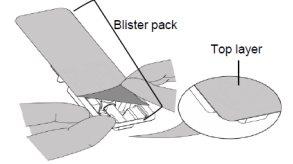
- Осторожно: не держите продукт за поршень или колпачок иглы. Удалите шприц из упаковки, держа его за корпус, как показано на изображении ниже.
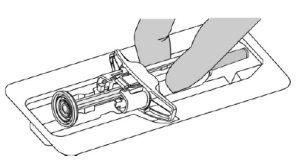
- Визуально осмотрите шприц. Вы должны быть able видеть желтоватую жидкость через окно для осмотра. Возможно, вы увидите небольшую пузырек воздуха, который не повлияет на инъекцию и не причинит вам вреда.
- Выберите место инъекции и продезинфицируйте его тампоном, пропитанным спиртом, который входит в комплект. Это занимает от 30 до 60 секунд. Подходящими зонами для инъекции являются кожа передней части брюшной стенки и кожа передней части бедра.
- Пока держите корпус шприца, удалите колпачок.
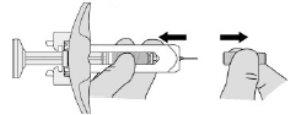
Ненажимайте на поршень до самоинъекции, чтобы удалить пузырьки воздуха. Если вы это сделаете, может произойти потеря лекарства. После удаления колпачка держите шприц в руке. Избегайте контакта шприца с любыми другими предметами. Это позволяет обеспечить чистоту иглы.
- Держите шприц рукой, которой вы пишете (как если бы это был карандаш), и другой рукой сделайте складку на коже, слегка сжимая кожу в месте инъекции большим и указательным пальцами. Убедитесь, что вы держите складку кожи во время всей инъекции.
- Переместите шприц к складке кожи (месту инъекции) с защитным колпачком иглы, указывающим直接 на место инъекции. Вставьте иглу до конца в складку кожи.
- Нажмите на поршень вниз пальцем до тех пор, пока шприц не опустеет. Таким образом, лекарство будет введено под кожу.

- Удалите иглу; для этого вытащите ее прямо. Защитный колпачок шприца автоматически покроет иглу, чтобы предотвратить травмы от уколов. Теперь вы можете отпустить складку кожи.
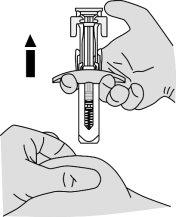
Примечание: система безопасности, выпускающая защитный колпачок, может быть активирована только тогда, когда шприц опустошен путем нажатия на поршень до конца. Чтобы избежать гематом, не трите место инъекции после введения.
- Утилизируйте шприц в контейнере для острых предметов, поставляемом с ним. Закройте плотно крышку контейнера и положите его вне досягаемости детей. В случае случайного контакта метотрексата с кожей или мягкими тканями промойте пораженную область большим количеством воды. Когда контейнер будет заполнен, передайте его вашему врачу или медсестре для утилизации. Не выбрасывайте его в мусор.
Если вы примете больше ИМЕТ, чем следует
Следуйте рекомендациям по применению, указанным вашим врачом. Не изменяйте дозу самостоятельно.
Если вы подозреваете, что вы (или другой человек) приняли слишком большое количество Имета, свяжитесь с вашим врачом или немедленно обратитесь в ближайшую больницу. Они решат, какие терапевтические меры необходимы в зависимости от тяжести отравления.
Передозировка метотрексата может вызвать серьезные токсические реакции. Симптомы передозировки могут включать синяки или кровотечения, необычную слабость, язвы во рту, тошноту, рвоту, черный стул или стул с кровью, кашель с кровью или рвоту, похожую на кофейную гущу, и уменьшение производства мочи. См. также раздел 4.
Возьмите с собой упаковку с лекарством, если вы посетите врача или больницу.
Антидот при передозировке - кальциевый фолинат.
Если вы пропустите использование ИМЕТ
Не принимайте двойную дозу, чтобы компенсировать пропущенные дозы, но продолжайте принимать назначенную дозу. Попросите совета вашего врача.
Если вы прекратите лечение ИМЕТ
Не должны прекращать или прерывать лечение Иметом, если только это не согласовано с вашим врачом. Если вы подозреваете серьезные побочные эффекты, немедленно свяжитесь с вашим врачом.
Если у вас есть какие-либо другие вопросы о использовании этого лекарства, спросите вашего врача или фармацевта.
4. Возможные побочные эффекты
Как и все лекарства, это лекарство может вызывать побочные эффекты, хотя не все люди испытывают их.
Немедленно сообщите вашему врачу, если вы испытываете внезапную слабость; затруднение дыхания; отек век, лица или губ; кожную сыпь или зуд (особенно если она распространяется по всему телу).
Серьезные побочные эффекты
Если вы испытываете любой из следующих побочных эффектов, немедленно свяжитесь с вашим врачом:
- Проблемы с легкими (симптомы могут включать общее недомогание, раздражающий сухой кашель, затруднение дыхания, чувство нехватки воздуха в покое, боль в груди или лихорадку).
- Кровь при кашле или откашливании.
- Формирование пузырей или сильная шелушение кожи.
- Необычные кровотечения (включая рвоту с кровью) или синяки.
- Сильная диарея.
- Язвы во рту.
- Черный стул или стул с кровью.
- Кровь в моче или стуле.
- Маленькие красные пятна на коже.
- Лихорадка.
- Желтушная окраска кожи (желтуха).
- Боль или затруднение при мочеиспускании.
- Жажда и/или частое мочеиспускание.
- Судороги (припадки).
- Потеря сознания.
- Размытое зрение или снижение зрения.
Также сообщались следующие побочные эффекты:
Очень частые: | встречаются более чем у 1 человека из 10. |
Частые: | встречаются у 1-10 человек из 100. |
Редкие: | встречаются у 1-10 человек из 1000. |
Очень редкие: | встречаются у менее 1 человека из 10000. |
Частота неизвестна: | не может быть оценена на основе доступных данных. |
Очень частые:
Потеря аппетита, тошнота (головокружение), рвота, боль в животе, воспаление и язвы во рту и горле, и увеличение печеночных ферментов.
Частые:
Снижение образования кровяных клеток с уменьшением количества лейкоцитов и/или эритроцитов и/или тромбоцитов (лейкопения, анемия, тромбоцитопения), головная боль, усталость, сонливость, воспаление легких (пневмония) с сухим непродуктивным кашлем, затруднением дыхания и лихорадкой, диарея, кожная сыпь, покраснение кожи и зуд.
Редкие:
Снижение количества кровяных клеток и тромбоцитов, головокружение, путаница, депрессия, судороги, воспаление кровеносных сосудов, повреждение легких, язвы и кровотечения в пищеварительном тракте, нарушения функции печени, диабет, снижение белков в крови, крапивница (отдельно), реакции, подобные солнечным ожогам, из-за повышенной чувствительности кожи к солнечному свету, коричневая окраска кожи, выпадение волос, увеличение ревматоидных узлов, герпес, болезненный псориаз, боль в суставах или мышцах, остеопороз (снижение костной массы), воспаление и язвы в мочевом пузыре (возможно, с кровью в моче), боль при мочеиспускании, серьезные аллергические реакции, воспаление и язвы в вагине и медленное заживление ран.
Очень редкие:
Воспаление мешка, окружающего сердце, жидкость в мешке, окружающем сердце, серьезные нарушения зрения, колебания настроения, низкое кровяное давление, кровяные сгустки, боль в горле, прерывание дыхания, астма, воспаление пищеварительного тракта, стул с кровью, воспаление десен, нарушение пищеварения, острый гепатит (воспаление печени), изменения цвета ногтей, акне, красные или фиолетовые пятна из-за кровотечения из кровеносных сосудов, переломы костей, почечная недостаточность, уменьшение или отсутствие мочи, нарушения электролитного баланса, дефекты формирования спермы и нарушения менструации.
Очень редкие:
Инфекции, тяжелая недостаточность костного мозга, тяжелая печеночная недостаточность, воспаление желез, бессонница, боль, мышечная слабость, онемение или покалывание/чувствительность ниже нормы, нарушения вкуса (металлический вкус), воспаление оболочки мозга, вызывающее паралич или рвоту, красные глаза, повреждение сетчатки глаза, жидкость в легких, рвота с кровью, лихорадка, белок в моче, лихорадка, потеря полового влечения, проблемы с эрекцией, инфекция вокруг ногтей, серьезные осложнения пищеварительного тракта, фурункулы, мелкие кровеносные сосуды на коже, грибковые инфекции, повреждение кровеносных сосудов кожи, вагинальные выделения, бесплодие и увеличение молочных желез у мужчин (гинекомастия), лимфопролиферативные расстройства (чрезмерное увеличение количества белых кровяных клеток).
Частота неизвестна:
Некоторые инфекции мозга (лейкоэнцефалопатия), легочное кровотечение, повреждение костей челюсти (вторичное по отношению к чрезмерному увеличению количества белых кровяных клеток), разрушение ткани в месте инъекции, покраснение и шелушение кожи, отек.
При введении метотрексата внутримышечно часто могут возникать местные побочные эффекты (чувство жжения) или повреждения (формирование стерильных абсцессов, разрушение жировой ткани) в месте инъекции. Подкожное введение метотрексата обычно хорошо переносится местно. Были обнаружены только легкие местные кожные реакции, которые уменьшались во время лечения.
Метотрексат может вызывать снижение количества лейкоцитов и может уменьшить вашу устойчивость к инфекциям. Если вы испытываете инфекцию с симптомами, такими как лихорадка и серьезное ухудшение общего состояния, или лихорадка с симптомами местной инфекции, такими как боль в горле, фарингит, боль во рту или проблемы с мочеиспусканием, немедленно обратитесь к вашему врачу. Будет проведен анализ крови, чтобы проверить возможное снижение количества лейкоцитов (агранулоцитоз). Важно, чтобы вы сообщили вашему врачу о вашем лекарстве.
Метотрексат может вызывать серьезные побочные эффекты (иногда опасные для жизни). Поэтому ваш врач будет проводить тесты, чтобы проверить, появляются ли аномалии в крови (например, низкое количество лейкоцитов, низкое количество тромбоцитов, лимфома) и изменения в почках и печени.
Сообщение о побочных эффектахЕсли вы испытываете любой побочный эффект, проконсультируйтесь с вашим врачом или фармацевтом, даже если это побочные эффекты, которые не перечислены в этом листке. Вы также можете сообщить о них напрямую через национальную систему уведомления, включенную в систему фармакологического надзора за лекарствами для человека: www.notificaram.es. Сообщая о побочных эффектах, вы можете способствовать предоставлению более полной информации о безопасности этого лекарства.
5. Хранение ИМЕТ
Храните это лекарство вне поля зрения и досягаемости детей.
Храните при температуре ниже 25°C.
Храните шприц в наружной коробке, чтобы защитить его от света.
Не замораживайте.
Не используйте это лекарство после срока годности, указанного на этикетке шприца и коробки после "Срок годности". Срок годности - последний день месяца, указанного.
Продукт должен быть использован сразу после открытия.
Не используйте Имет, если раствор не прозрачный и содержит частицы.
Для одноразового использования. Утилизируйте любой оставшийся непринятый раствор. Лекарства не должны выбрасываться в канализацию или мусор. Поместите упаковку и лекарства, которые вам больше не нужны, в пункт сбора SIGRE в аптеке. Если у вас есть сомнения, спросите вашего фармацевта, как утилизировать упаковку и лекарства, которые вам больше не нужны. Таким образом, вы поможете защитить окружающую среду.
6. Содержание упаковки и дополнительная информация.
Состав ИМЕТХ
- Активное вещество - метотрексат. 1 мл раствора содержит 25 мг метотрексата.
- Другие компоненты - хлорид натрия, гидроксид натрия и вода для инъекционных препаратов.
Внешний вид ИМЕТХ и содержание упаковки
Предварительно заполненные шприцы Иметх содержат прозрачный и желтоватый раствор. Предварительно заполненные шприцы оснащены инъекционной иглой и устройством безопасности для предотвращения травм от уколов иглы и его повторного использования.
Доступны следующие размеры упаковки:
Предварительно заполненные шприцы по 0,3 мл, содержащие 7,5 мг метотрексата.
Предварительно заполненные шприцы по 0,4 мл, содержащие 10 мг метотрексата.
Предварительно заполненные шприцы по 0,5 мл, содержащие 12,5 мг метотрексата.
Предварительно заполненные шприцы по 0,6 мл, содержащие 15 мг метотрексата.
Предварительно заполненные шприцы по 0,7 мл, содержащие 17,5 мг метотрексата.
Предварительно заполненные шприцы по 0,8 мл, содержащие 20 мг метотрексата.
Предварительно заполненные шприцы по 0,9 мл, содержащие 22,5 мг метотрексата.
Предварительно заполненные шприцы по 1,0 мл, содержащие 25 мг метотрексата.
Инъекционный раствор в упаковках по 1, 4, 6 и 24 предварительно заполненных шприца.
Каждая упаковка по 1, 4, 6 и 24 предварительно заполненных шприца содержит 2, 8, 12 и 48 ватных шариков с алкоголем соответственно.
Возможно, не все размеры упаковки будут продаваться.
Владелец разрешения на маркетинг и производитель
Владелец разрешения на маркетинг
Nordic Group B.V.
Сириусдреф 41
2132 ВТ Хофддорп
Нидерланды
Вы можете запросить дополнительную информацию о этом лекарстве, обратившись к местному представителю владельца разрешения на маркетинг:
Nordic Pharma SAU
Адольфо Перес Эскивель 3, 2-й офис 17.
28232 Лас-Росас (Мадрид)
Испания
Производитель
Cenexi - Laboratoires Thissen SA
Рю де ла Папире 2-6, Брен-л'Алью, Валлонский Брабант
Б-1420
Бельгия
Это лекарство разрешено в государствах-членах Европейского экономического пространства под следующими названиями:
Франция:
ИМЕТХ 7,5 мг/0,3 мл, раствор для инъекций в предварительно заполненном шприце
Нидерланды
Метотрексат Нор�к 7,5 мг, раствор для инъекций в предварительно заполненном шприце
Великобритания
Златал 7,5 мг, раствор для инъекций в предварительно заполненном шприце
Дата последнего обзора этой инструкции: Август 2024
Подробная и актуальная информация о этом лекарстве доступна на сайте Испанского агентства по лекарствам и медицинским изделиям (AEMPS) http://www.aemps.gob.es.

Сколько стоит ИМЕТ 7,5 мг/0,3 мл раствор для инъекций в предварительно заполненном шприце в Испании в 2025 году?
Средняя цена на ИМЕТ 7,5 мг/0,3 мл раствор для инъекций в предварительно заполненном шприце в декабрь, 2025 года составляет около 43.52 евро. Финальная стоимость может зависеть от региона, конкретной аптеки и рецептурного статуса. Для точной информации лучше проверить онлайн или в ближайшей аптеке.
- Страна регистрации
- Средняя цена в аптеках43.52 EUR
- Активное вещество
- Требуется рецептДа
- Производитель
- Информация носит справочный характер и не является медицинской рекомендацией. Перед приемом любых препаратов проконсультируйтесь с врачом. Oladoctor не несет ответственности за медицинские решения, принятые на основе этого контента.
- Аналоги ИМЕТ 7,5 мг/0,3 мл раствор для инъекций в предварительно заполненном шприцеФорма выпуска: ИНЪЕКЦИОННЫЙ РАСТВОР, 10 мг/ 1 млАктивное вещество: МетотрексатПроизводитель: Ebewe Pharma Ges.M.B.H. Nfg.KgТребуется рецептФорма выпуска: ИНЪЕКЦИОННЫЙ РАСТВОР, 15 мгАктивное вещество: МетотрексатПроизводитель: Ebewe Pharma Ges.M.B.H. Nfg.KgТребуется рецептФорма выпуска: ИНЪЕКЦИОННЫЙ РАСТВОР, 20 мгАктивное вещество: МетотрексатПроизводитель: Ebewe Pharma Ges.M.B.H. Nfg.KgТребуется рецепт
Аналоги ИМЕТ 7,5 мг/0,3 мл раствор для инъекций в предварительно заполненном шприце в других странах
Лучшие аналоги с тем же действующим веществом и терапевтическим эффектом.
Аналог ИМЕТ 7,5 мг/0,3 мл раствор для инъекций в предварительно заполненном шприце в Польша
Аналог ИМЕТ 7,5 мг/0,3 мл раствор для инъекций в предварительно заполненном шприце в Украина
Врачи онлайн по ИМЕТ 7,5 мг/0,3 мл раствор для инъекций в предварительно заполненном шприце
Консультация по дозировке, побочным эффектам, взаимодействиям, противопоказаниям и продлению рецепта на ИМЕТ 7,5 мг/0,3 мл раствор для инъекций в предварительно заполненном шприце – по решению врача и с учетом местных правил.





